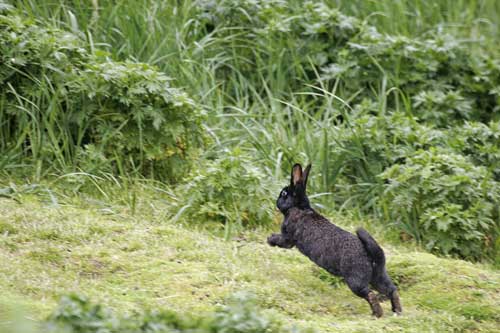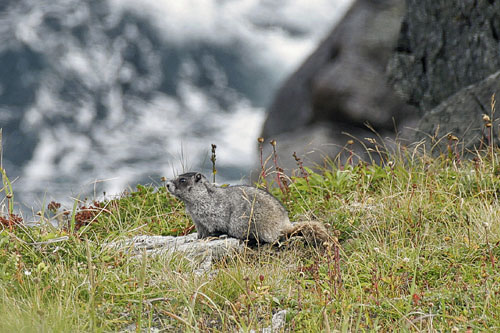
Alaska Science Rabbits and marmots as island invaders December 02, 2010
In the 1940s, a man who lived in Akutan tasted rabbit for the first time while working with United States Navy Seabees on Hog Island near Unalaska. He liked the meat so much that he brought a few bunnies home with him. He released them on a 134-acre island 12 miles from his home village, a place he liked to gather bird eggs. Long after the man stopped hunting them, the rabbits endured.
European rabbit on Poa Island.
After early spring trapping and hunting of rabbits and marmots on the islands, Sud Island probably has no more marmots. Some rabbits probably remain on Poa Island, according to Steve Ebbert, a biologist with the refuge, who gave a talk recently in Fairbanks. “We put four guys on the island from February to May,” Ebbert said of the rabbit-removal effort on Poa Island. “They took 342 rabbits. I don’t think we got them all, and the trappers pulled our traps and nets after the puffins came back.” European rabbits don’t mix well with ground-nesting puffins because rabbits, rather than digging their own burrows, use the ones puffins have dug. Rabbits enjoy sole occupancy of the holes all winter, but when puffins return to the island to nest, rabbits don’t move out. Not comfortable with rabbits at their door, puffins often abandon their eggs inside, Ebbert said. Both rabbits and marmots make seabirds more vulnerable by trimming the grasses at burrow entrances.
A hoary marmot on Sud Island.
The rationale for the Alaska Game Commission’s stocking of Sud Island with marmots is a mystery to Ebbert, who found the remains of a 15-man barracks on the island, which, like Poa Island, is home to no people today. He suspects the game commission might have released marmots on the island to provide an easy food source even though marmots would have been unavailable during winter when the animals hibernate. The marmots took to their maritime home at the expense of rhino auklets, seabirds with elaborate headfeathers that nest on only two other islands in the vast refuge, which includes more than 2,500 islands in Alaska. Marmots may break the eggs of the burrow nesters, and also graze on the grass in which auklets prefer to nest. On a visit to Sud Island in 2009, Ebbert and fellow biologist Leslie Slater found bird burrows in a steep cliff. They looked like the type rhino auklets would excavate. The biologists didn’t confirm the presence of rhino auklets until months later, when they developed the film from a motion-sensitive camera they had aimed at the burrows. So, the rhino auklet - of which a refuge biologist counted 1,500 in two areas of the island in 1980 and another biologist counted zero in 1994 - still exists on the island. Ebbert hopes that rhino auklets will soon expand their range, because two hunters that refuge staff placed on the island for two months this year were confident they had killed all the marmots there. But Ebbert cautioned that only with reexaminations of the islands a few years into the future could biologists tell for sure whether a species has been removed.
This column is provided as a public service by the Geophysical Institute,
Publish A Letter in SitNews Read Letters/Opinions
|

